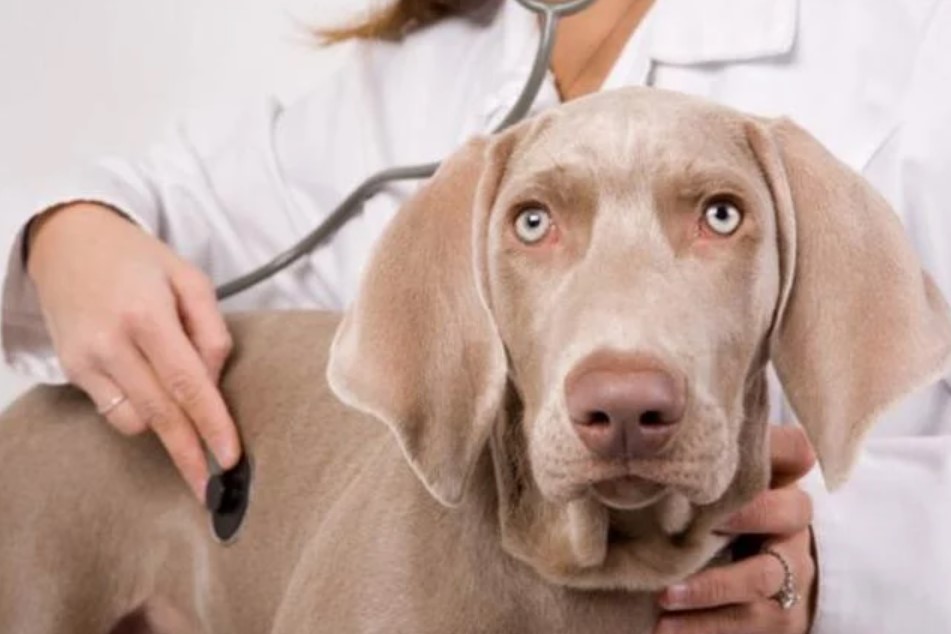Canine liver disease is a difficult diagnosis, but highly treatable. The function of the liver in dogs is of great importance for a functioning organism. It is significantly involved in the body’s own detoxification processes. If the work of the liver is restricted by a disease, poisoning will gradually spread throughout the body. In the worst case, liver disease in dogs can therefore also be life-threatening for the affected animal and end in death. In order to be able to identify liver disease in dogs as early as possible and to take the four-legged friend to the vet in good time, every dog owner should know the causes and symptoms of liver disease in dogs.
Anatomy of the dog liver

The dog’s liver is located in the front part of the abdomen and is well protected behind the ribs. It is the largest internal organ and has around 1500 different functions that are important for metabolism.
A dog’s liver consists of seven lobes, each of which is divided into different subunits. Each liver lobe is shaped like a hexagon and is made up of specialized liver cells, also known as hepatocytes. Depending on the size and breed of the dog, its liver weighs between 125g and 1.4kg. On the underside of the liver lies the gallbladder, which is protected by the lobes of the liver.
Basic functions of the liver in dogs
The liver cells that make up the liver are traversed by innumerable blood vessels. During this transport of blood from the hepatic artery and the portal vein over to the dog’s central vein, the nutrients and toxins contained in the blood are also carried through the liver. Their function is to absorb and metabolize these substances.
Removal of toxins and pollutants
Depending on what kind of substance is absorbed, the further path of this substance is determined. Nutrients that are important for the body are stored so that they can benefit the body. Toxic or harmful substances that would burden the dog’s body are destroyed and broken down by the liver. In these processes, a distinction is made between different types of metabolism that make up the basic functions of the liver. Fat metabolism, sugar metabolism and protein metabolism take place in the liver, depending on which nutrient is reaching the liver.
Energy for mental and physical activities
During lipid metabolism, the fat contained in the blood is removed from it and stored in the hepatocytes. The energy that the dog’s body needs for all kinds of activities is obtained from these fat stores. Insulin, a hormone produced in the pancreas and then made available to the liver, is needed to metabolize sugar. Insulin helps to store sugar in the form of glycogen so that it can also be used as body energy.
The driver of protein metabolism

In the third metabolic process, protein metabolism, the liver receives the amino acids that makeup protein and converts some of them into carbohydrates, which in turn are stored as glycogen. The amino acids that cannot be metabolized become ammonia, a toxic waste product that the body does not need. Accordingly, ammonia is carried out of the body by the liver via the urine.
Production of coagulation proteins
The last important basic function of the liver is the production of coagulation proteins, which are responsible for blood clotting. If the formation of these substances is disturbed, the diseased dog will develop a coagulation disorder. In the case of an open wound, there is a risk of bleeding to death, even if the wound itself is not very large and would hardly be dangerous in a dog without a clotting disorder. The myriad other jobs the liver does are each essential to a healthy organism, which is what makes the liver such an important and admirable worker in the body.
The various liver diseases
In addition to congenital liver diseases, there are also diseases that only appear in the course of a dog’s life. Congenital diseases are portosystemic shunt or copper storage disease. The portosystemic shunt, also called liver shunt, is a malformation of the organs. In a healthy dog, blood flows through the liver, which rids it of toxins. It then flows to other organs and supplies them with important substances. When an animal has a liver shunt, the liver is bypassed for blood circulation and the uncleaned blood goes to other organs. Thus, a gradual internal poisoning occurs.
Copper storage disease is also known as Wilson’s disease or copper toxicosis. It is a genetic disorder of copper metabolism. The dog’s body stores copper excessively. The trace element is deposited in the liver and other organs. Various dog breeds suffer more from this genetic defect. These include the Bedlington Terrier, the Dalmatian or the West Highland White Terrier.
Other liver diseases occur over the course of a dog’s life. These include hepatitis, liver fibrosis, obesity and liver tumors. In addition, medication and other poisonings permanently damage the dog’s liver.
What liver diseases are there in dogs?
There are congenital diseases, such as copper storage disease or portosystemic shunt, which are caused by genetic errors. Non-congenital liver diseases include liver tumors, hepatitis, severe overweight (obesity), poisoning, e.g. by rat poison, or liver fibrosis. Prolonged use of medication can also damage the liver.
Causes of liver disease in dogs
Liver disease in dogs can have a variety of causes. On the one hand, it can be congenital due to genetic errors. But the liver can also be so heavily burdened by certain medications, viruses or bacteria that it becomes diseased. Being overweight in dogs also damages the liver, as excess fat is eventually stored in the liver tissue when the body no longer knows where to store it. This fat then damages the delicate tissue of the liver, severely reducing its many functions.
Some dog breeds, such as Dalmatians, Doberman pinschers or various breeds of terriers, have a genetic predisposition to liver disease. In these breeds, the liver values should therefore be checked regularly and any symptoms that occur should be considered with regard to liver disease.
Symptoms of liver disease in dogs
The first symptoms associated with liver disease are usually quite unspecific and can also occur with other diseases. It is therefore very difficult to detect liver damage at an early stage and even experienced veterinarians usually make other diagnoses at first.
Dogs with liver disease often experience tiredness, loss of appetite, diarrhea, vomiting, fever or noticeable weight loss. An already advanced liver disease shows symptoms such as jaundice (yellow discolored mucous membranes), swollen tissue, a noticeably bloated abdomen and seizures.
What is liver disease in dogs?

The first symptoms can be diarrhoea, vomiting, fever, weakness, loss of appetite and the associated weight loss. Bloated tissue and yellow mucous membranes indicate a severely advanced liver problem.
Liver disease in dogs – diagnosis and treatment methods
The diagnosis of such a disease of the liver is based on liver values measured in the blood. A biopsy of the liver can also provide information about what the dog is suffering from. A tiny part of the liver is removed and examined in the laboratory. If liver disease is diagnosed, treatment usually lasts a very long time, but is also very promising. Since the liver is a very resistant organ, which has a high regeneration potential, even acute illnesses are usually easy to get under control.
In some cases of inflammation that are due to bacteria, the dog is first given antibiotics to fight that inflammation. The diet of the sick animal plays a particularly important role in the further treatment plan. Most of the time it has to be changed completely. By changing the composition of the feed, the still functional part of the liver should be relieved and thus have more power for the regeneration of the remaining parts of the liver.
What to do if a dog has a liver disease?
As a first measure, the inflammation of the liver is treated with medication and the dog is usually given a lot of liquid. In the long term, the dog’s food must be changed and the dog put on a liver diet. This allows the liver to regenerate and the animal to have a few more happy, symptom-free years.
Liver disease in dogs: nutritional tips
A protein-reduced bland diet is suitable for dogs with impaired liver function, so that the toxic breakdown product ammonia, which is produced during protein metabolism, is eliminated. In addition, the feed should contain high-quality fatty acids and as little sodium and copper as possible. Zinc contained in the feed ensures the absorption of copper from the intestine.
Fibrous substances, which are contained in carrots or sugar beet pulp, for example, can prevent the absorption of ammonia in the intestine and thus reduce ammonia poisoning. The administration of bitter substances, such as milk thistle, has also proven itself in a liver diet. The bitter substances strongly stimulate the cells of the liver to regenerate and minimize existing inflammation.
In the case of liver disease, only the prescribed diet food should be fed. Treats or chews have to be eliminated from the dog’s diet because they usually contain too many waste products that the diseased liver cannot metabolize. It is important that the diet is coordinated with the attending veterinarian so that it is coordinated with the treatment.
Which food is recommended for dogs with liver disease?
In the case of liver diseases, high-calorie feed with a low protein content, high-quality fatty acids, and bitter and fibrous substances is particularly recommended. The copper and sodium content of the feed should be low, while the zinc content should be relatively high.
The course of healing and preventive measures

As long as a complete, irreversible cirrhosis of the liver has not yet developed, the liver usually recovers to a large extent and the affected dog can lead a normal life if certain measures are observed. The prognosis of liver disease is therefore quite good, especially if the disease can be detected early. However, a comprehensive recovery of the liver requires a lot of time and patience and is not done immediately, since the organ only regenerates step by step.
In order to prevent liver diseases, great importance should always be attached to high-quality and balanced feed. Overweight should also be avoided at all costs in a dog. The administration of medication that puts a strain on the liver should always be limited in time and should be accompanied by regular monitoring of the liver values in order to prevent the organ from being overloaded and thus causing lasting damage or failure. The exact chances of recovery should be discussed with the treating veterinarian.





























